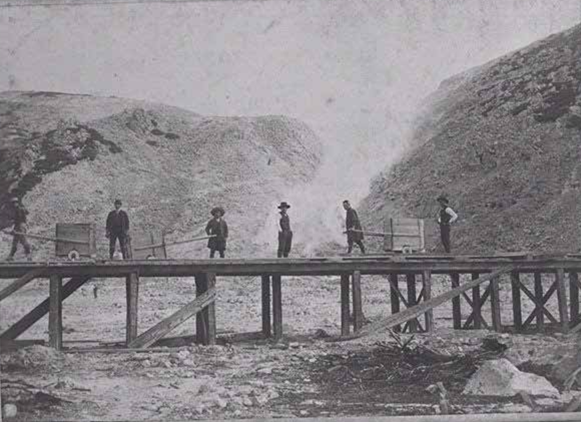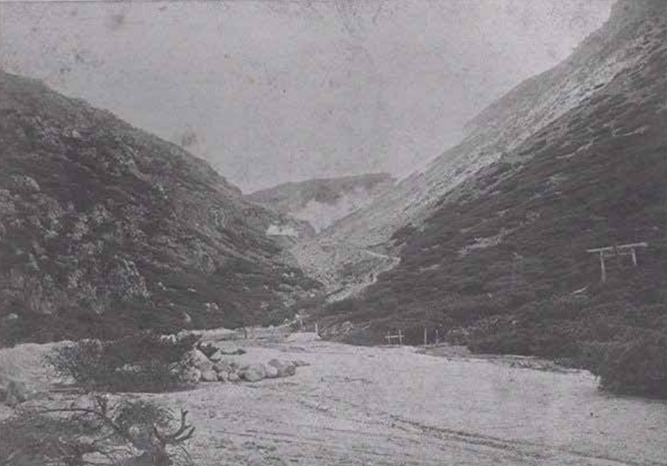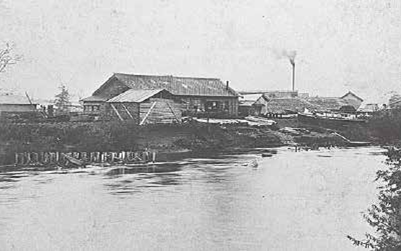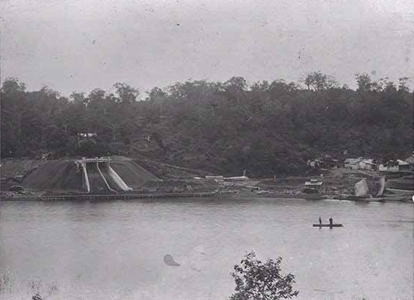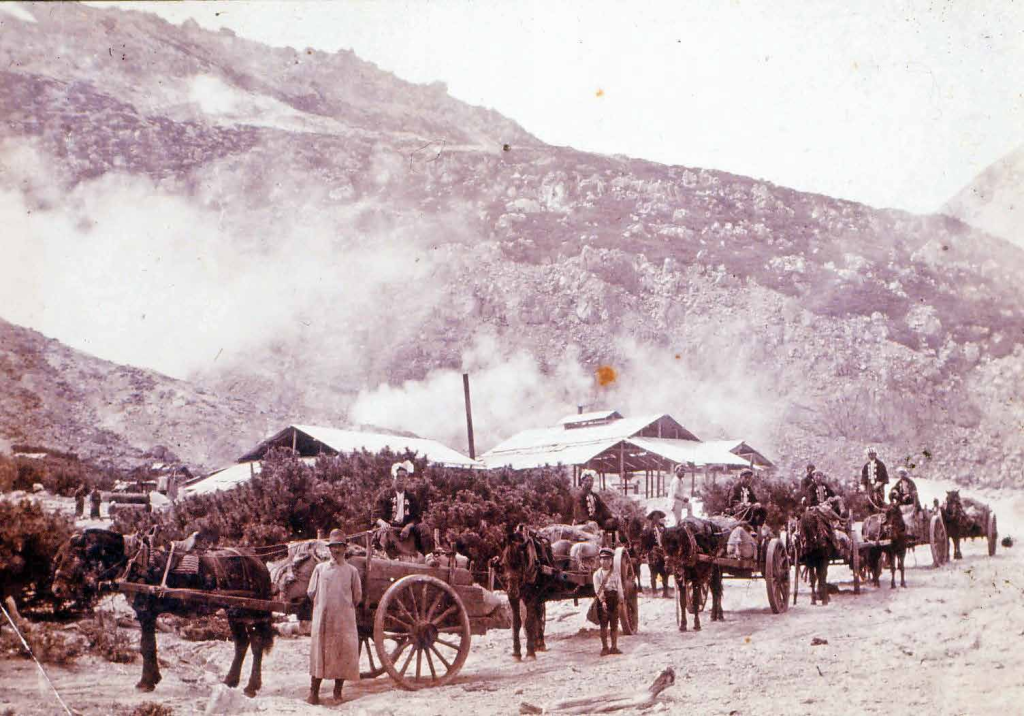HISTORY01 The beginning of the mining business at “Mt. Io”

Sulfur mining as a business venture
The Ainu people used to call Kawayu “seseki petu” (hot river).
Mining at Mt. Io was started in 1876 by the fourth generation, Sano Magoemon, who lost various rights that could be a source of income due to the abolishment of the fishing ground ownership (location contractor) system. It all began with the search for a new source of revenue and the start of a business. When the business started in 1877, it was the second largest sulfur mine in Hokkaido. Sulfur was one of the leading exports at the time.
Initial mining and smelting operations were conducted using traditional methods.
Smelting was carried out at a smelter built at the southern foot of Mt. Io using a traditional method called “darani.”
① Place a pot and cauldron in a furnace built with clay and stones,
② Put the ore in this and boil it down.
③ Transfer the melted sulfur to a kettle,
④ Remove light objects such as burnt stones and ash by floating them, and let heavy stones and muddy sand settle.
⑤ Pour the pure sulfur into a separate bucket,
⑥It takes one day in winter and one and a half days in summer to cool the product. ⑦The product sulfur was transported by horse and boat.
HISTORY1 硫黄山での採掘事業のはじまり
ベンチャービジネスとしての硫黄採掘
かつてアイヌの人々は、ここ川湯をセセクペッ(熱い・川)と呼んでいました。 硫黄山での採掘は、1876(明治9)年、漁場持(場所請負人)制度が廃止されことにより、収益源となるさまざまな権利を失ってしまった、四代目「佐野孫右衛門」が新たな 収益源を模索し、事業を開始したことにはじまります。事業開始年(1877年)は北海道2番目の生産量となる硫黄鉱山。硫黄は当時、有力な輸出品の1つでした。
初期の採掘・製錬作業は伝統的方法で
製錬は硫黄山の南麓に設けられた製錬場で「だら煮」といわれる伝統的な方法で行われました。
1.土石で築いたかまどに、鍋釜を据え、
2.この中に鉱石を入れて煮詰め、
3.融けた硫黄を汲釜に移し、
4.焼け石や灰などの軽いものを浮かせ取り除き、重い石や泥砂は沈ませておきます。
5.混ざり物のない硫黄を別な桶に汲み入れ、
6.冬は1日、夏は1日半かけて、冷却し製品にしていました。
7.製品となった硫黄は馬と船で運搬していました。
HISTORY2 Management of Mt.Io was transferred from Sano to Yamada.
Expand mining volume by hiring more miners and using prisoners
Sano’s sulfur mine business was going well, but due to illness, he retired in 1880.
Afterwards, Nishikawa Kouemon, who was involved in management, increased sulfur production, but the business did not go well.
In 1885, Nishikawa transferred the mine to Yamada Shin of Hakodate, who had borrowed money for the mine.Yamada was born in 1852 in what is now Fukui Prefecture and was an up-and-coming businessman involved in banking and other businesses.
Yamada doubled the production volume by increasing the number of miners and employing prisoners at low wages, but the mine’s management did not go well due to lack of funds and debt due to poor management of the bank, which was the company’s main business.
Yamada asked Zenjiro Yasuda for relief using the mine as collateral.
From 1887, Yasuda and Yamada began managing the mine jointly.
HISTORY2 硫黄山の経営は佐野から山田へ
鉱夫増員・囚人使役で採掘量拡大
佐野の硫黄山事業は順調でしたが、病気のため1880(明治13)年、四代目佐野孫右街門は引退。その後、経営に携わった西川幸右衝門は、硫黄の生産量は増加させたものの経営的にはうまく行かず、1885 (明治18)年、鉱山は資金を借り入れていた函館の山田 慎へ譲渡されます, 山田は1852年に現在の福井県内に生まれ、銀行業など手がける気鋭の実業家でした。
山田は鉱夫を増員するとともに、囚人を 安い賃金で使役するなどで生産量を倍増させましたが、資金不足と本業である銀行経営の失敗で借金が重なったため、鉱山経営も結果としてうまくいかず、鉱山を担保に安田善次郎に救済を求めました。
こうして1887(明治20)年からは、鉱山経営を安田・山田の共同で行うことになります。
HISTORY3 Investor appears Modernizing sulfur mining
Management of modern mines by Yasuda Zenjiro

Yasuda Zenjiro was born in 1838 in the late Edo period as the son of a low-class samurai in the Toyama domain, and was the man who built the Yasuda Zaibatsu, a financial conglomerate that included Yasuda Bank.
Under joint management with Yamada from 1887, Yasuda sought to expand production by introducing modern technology on a large scale.
It was not only a collection of the loan to Yamada, but also an “investment” that would bring in a lot of profit.
In addition to introducing steam smelting, efforts were made to improve efficiency by using railways (Atosanobori to Shibecha) and steamships (Shibecha to Kushiro) to transport ore. As a result, annual production was in the 20,000-ton range.
The second railway built in Hokkaido
It was the second railway in Hokkaido, following the “Horonai Railway” (Temiya – Sapporo – Horonai), which connected the coal mine and the port, and the total construction cost was 170,000 yen.It was a huge undertaking, equivalent to approximately 4 billion yen in today’s monetary value.
The two steam locomotives used were made by the American Baldwin Company, and were named “Choan” and “Shinzen”, one letter after Yasuda Zenjiro.
Initially, it was a railway exclusively for mining, but in 1891, it became known as the “Kushiro Railway” under the Private Railway Ordinance, and the general public began to be able to ride on it for a fee.
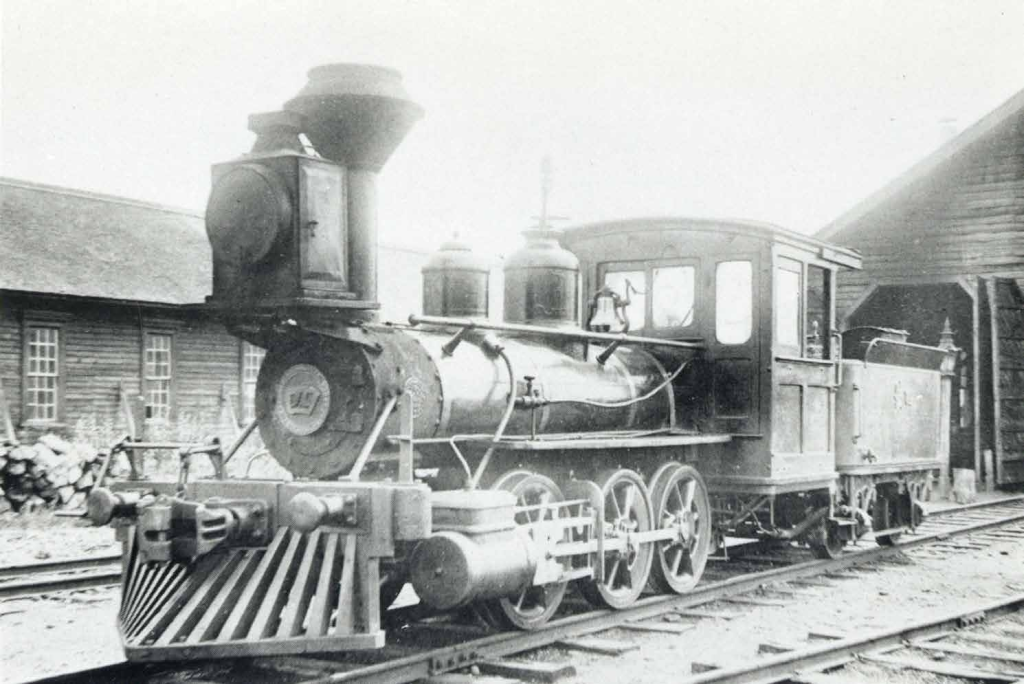
HISTORY3 投資家あらわる 近代化する硫黄採掘
安田善次郎による 近代的鉱山の経営
安田善次郎は江戸時代後期の1838年、富山藩の下級武士の子として生まれ、安田銀行をはじめとする金融財閥「安田財閥」を築いた人物です。1887(明治20)年からの山田との共同経営では、安田は大規模で近代的な技術導入により生産拡大を図ります。山田への貸付金の回収だけでなく、多くの利益を 得る「投資」でもありました。
蒸気製錬を導入するとともに、鉱石輸送用の鉄道(跡佐登〜標茶)と蒸気船(標茶~釧路)による輸送など、効率化を図りました。これにより、年産2万トン台となる生産を行いました。
北海道で2番目の鉄道
安田は1887(明治20)年、硫黄山から標茶までの約41kmの鉄道を、わずか8ヶ月という短期間で完成させました。炭鉱と港を結んだ「幌内鉄道」(手宮〜札幌〜幌内)に続く道内2番目の鉄道で、総工費は17万円、現在の貨幣価値に換算すると約40億円という大事業でした。
使用された蒸気機関車は、アメリカ・ ボールドウィン社製の2両で、安田善次郎から一字ずっとって「長安号」「進善号」と命名されました。 当初は鉱山専用の鉄道でしたが、1891 (明治24)年には私設鉄道条例による「釧路鉄道」として、運賃をとって一般の人々も乗せるようになりました。
HISTORY4 Prosperity of surrounding areas and end of sulfur mines
Regional development brought about by sulfur
Yasuda established a smelter in Shibecha because the steam smelting process he introduced required a large amount of water, and because it was conveniently located as a junction between railway transportation and boat transportation on the Kushiro River. As a result, Shibecha became very prosperous as the center of the Kushiro area at that time.
In addition, Kushiro Port was designated as a special export port in 1890 for the purpose of exporting sulfur (in 1899, it became a regular trading port). In 1887, “Harutori Charcoal Mountain” was opened on the shores of Harutori Lake in Kushiro to use as fuel for smelting and transporting sulfur. These became the foundation of Kushiro City, the key city in eastern Hokkaido.
The end of sulfur mines
As Yasuda and Yamada’s joint management period (10 years) was coming to an end and sulfur ore was becoming scarce, Yasuda closed the mine in July 1896 and returned the mining rights to Yamada.
Since then, sulfur mining at the Sulfur Mountains has gone through periods of production and suspension. After World War II, the “Atosato Sulfur Mining” was known for its high level of technical ability, but it ceased production in 1963. After that, a large amount of recovered sulfur, a byproduct of oil refining, became available, and the operation was never restarted.
HISTORY4 周辺地域の繁栄と硫黄鉱山の終焉
硫黄がもたらした地域の発展
安田は導入した蒸気製錬に大量の水が必要なこと、また鉄道輸送と釧路川での舟運の結節点としての利便性から、製錬場を標茶に設けました。これにより標茶は当時、釧路地域の中心として大いににぎわいました。
また硫黄の移出・輸出のため、1890 (明治23)年に釧路港が特別輸出港に指定されます(1899年に普通貿易港)。また硫黄の製錬・輸送の燃料用として、1887 (明治20)年に釧路の春採湖畔に「春鳥炭山」が開かれます。これらは、道東の基幹都市・釧路市の礎となりました。
硫黄鉱山の終焉
安田は山田との共同経営期間(10年)が終了すること、また硫黄鉱石もとぼしくなってきたことから、1896(明治29)年 7月をもって休山とし、採掘権を山田に戻しました。
硫黄山での硫黄採掘はその後、生産と休止を繰り返しました。戦後、生産を行った「跡佐登硫黄鉱業」は技術力の高さなどで知られていましたが、1963(昭和38)年に休止、その後、石油精製時の副産物である「回収硫黄」が大量に出回るようになり、再開することはありませんでした。
About NATURE05 in preparation…
NATURE05については準備中です。

Translation uses Google Translate.
翻訳はグーグル翻訳を使用しています。



